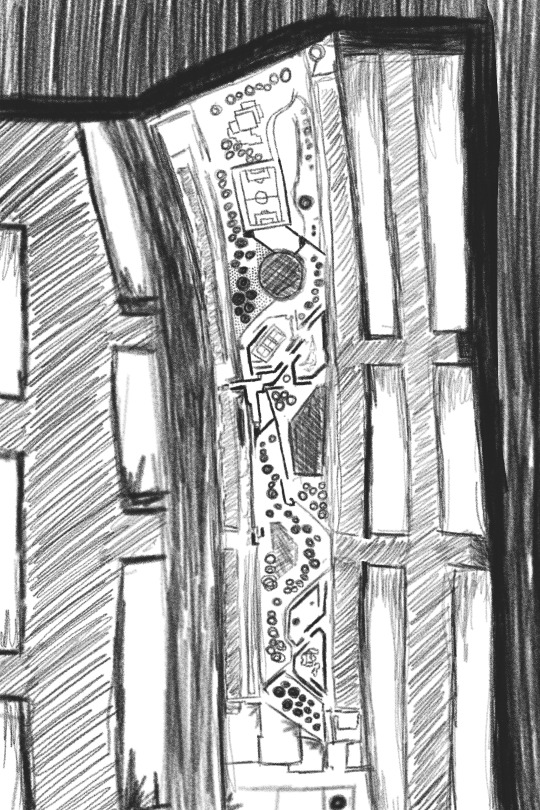Text
How does installation art battle with the idea of humans vs machines?
By Marta Kepinska, 10 April 2023
“Machines are the creation of humans, and they were created to make their work easier.”
The talk about machines taking over the world has been one in the works for an extensive amount of time. The first rise of machines came from the industrial revolution in the 18th Century; a time where hand made economies quickly transformed into mass production machinery. These produced items faster and cheaper. Nowadays, it is difficult to imagine a world without these machines. Humans depend on them massively for various day to day activities. It's almost impossible in the modern world to imagine a life with no machines. Many artists have dove deep into the idea of humans and machines and have shown their own renditions of the concept.

From the 11th of May to the 24th of November 2019, an installation piece by the name ‘Can’t Help Myself’ was exhibited in la biennale di venezia. Created by Sun Yuan and Peng Yu, the machine was created to clean its own oil, a red liquid closely resembling blood. Considering most of Yuan and Yu’s installations “represent death, perception and human condition”, it is not difficult to make the connection between how this machine represents humans. The intention of the creator is to provoke the audience into thinking much more deeply and to reflect on modern-day issues. It is said that the work “is intended to represent governments’ attempts at using machinery and modern advances in technology in order to protect themselves and their countries.” (Tara McCollough, 2020). The machine represents the government, the blood that pours out of it and is swept back in represents the citizens, who are constantly pushed back into their countries after trying to escape. It also conveys the pain of many immigrants. When all they want to do is to build a new life, but factors like government officials constantly reject them and helicopter the borders. The blood in this case can also “represent the violence that occurs in border zones”.
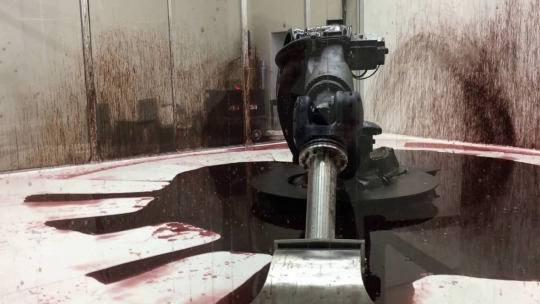
Despite the main installation being based around government and civilian relationships and the advances in technology, many people have voiced their own interpretations of this piece on social media. In 2021, the installation piece went viral on TikTok, with short clips of the piece accumulating over fifty million views. Many different comments sympathize with the robot, often relating to it and seeing themselves in the piece. This even led to many people personifying the machine, referring to it as ‘he’. Others commented: “he looks so tired…”, “I feel like this machine” and “I want to help him”. (TikTok) Humans have a tendency of anthropomorphism, and when an object feels like it comes to life or it feels like it represents a human emotion, intention or characteristic we tend to feel like it is one of us. The way a lot of machines are built, also often include human characteristics. Sometimes a car may look like its smiling, a lot of machines are now built with sound and voices, and in this particular installation the machine is built into an endless cycle of work. Starting off strong and quick but nearer to the end of its life it gets slower, the area around it isn't kept as well, it feels burnt out.
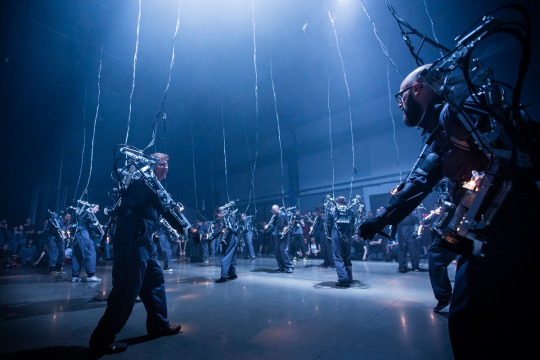
Another successful installation that depicts the idea of humans vs machinery is a piece called Inferno. Created by Louis-Phillippe Demers and Bill Vorn, Inferno is a "participative robotic performance project" (Cyber arts, pg 74) influenced by the idea of control. The performance piece is based around robotic entities, also known as 'The Mechanical Boy'. They are then dressed by members of the audience, leaving them in complete control of a robotic entity. The robotic entity is programmed into a cycle which forces the participant to move endlessly, sometimes allowing the participating member to move freely, but usually they are completely immersed and controlled by the machine. “Inferno questions the nature of control - either machinic or human'' (Cyber arts, pg 74). Wearing the robotic skeleton or being entrapped in it also pays homage to the concept of the Cyborg which first emerged in the late 80s. The idea of not only being trapped in a robotic entity but also being controlled by one to me is quite significant and slightly terrifying. With the modern world being vastly operated by machinery, completely submitting to a machine is something humans do subconsciously, such as with phones, TV or even a lift. This installation, although also made to depict the levels of hell, really opens your eyes and allows you to think about the significance of machines in our lives.

Pathfinder. A project that “aims to contribute to the creative processes of choreographic development” (Christian Mio Loclair). Pathfinder is an interactive installation that produces various graphical patterns to increase a dancer's creativity, flow and confidence. It is an “experimental tool” which strives to create original dance patterns rather than recreate existing ones, it therefore stands as its own “creative building block”. Unlike Inferno, The algorithm it is programmed by, allows the dancer to control the machine. It allows you to change the “speed, complexity or geometric objects” flowing spontaneously and morphing into each other in a sequence like structure. The dancer is then able to move organically with the machine's unpredictable movements, leaving the machine to guide them as they themselves interpret each sequential movement differently. In contrast to the other installations, such as Can’t Help Myself or Inferno, Pathfinder is perceived more as a helpful machine to humans. The installation was created to guide the humans, not to control them. It allows the human to take charge whilst surprising them with subtle lights and shapes that guide them along their way. Inferno was a much more devilish installation, almost apocalyptic, supporting the idea of machines taking over. Whereas Pathfinder is a much lighter approach, a welcoming one.

One newer approach to art is AI. One surreal installation artist, Refik Anadol, uses millions of little pieces of data in order to show how he interprets our future. “I was always trying to speculate this idea of ‘Can data become pigment?’... But what I’m trying to do as an artist is find an algorithm that can narrate the moment of data”. He uses this algorithm and machines to create visual images which he calls “Data Sculptures”. In the image above (Figure .05) we see one of the most well known of Anadol’s installation projects, Machine Hallucinations. The installation is made up of 113 million images of New York that Anadol found online. Out of the 113 million images, only 10 million are used as he only keeps the images without people in it. By collecting only images of animals, buildings, plants and landmarks, the machines are able to adapt to create an environment on what is a “collective memory of New York” (Wired, Refik Anadol, 2020). As the machine continues to learn, it takes these collective images and creates movement through similar images. The result is often a beautiful life cycle of the environment, displaying the different areas or changes that have occurred overtime.

Anadol believes this machine looks at information like a human being would, in turn creating a collective memory of an environment from a human point of view. Some of his works also show the development and architectural achievements humans have reached. A particular building can be viewed by thousands of people, (Figure .06) all capturing a different angle, different lighting or a different time. In Refik Anadol’s eyes the machine is dreaming. This personification of the machine makes it feel more human. As it is built to think like one, the images it creates feel organic as if a human has created them. Similar to the Pathfinder exhibition, Anadol’s rendition of humans and machines is much more passive. His installations are one of the best examples of what art galleries in the future may look like. Digitally created art and flows and moves and is constantly changing. However, similarly to the installation Can’t Help Myself, Anadol anthropomorphizes the AI. By saying it thinks like a human, collects memories and is described by him as dreaming, it personifies the machine, blurring the lines between humans and robots and technology and art.

The last example that I wanted to mention is based off of the immersive Vincent Van Gogh Exhibition. This exhibition was advertised everywhere and a huge hit for contemporary art lovers and tourists. The immersive installation, brings the traditional art created by Vincent Van Gogh to a virtual reality, completely submerging the viewer into it. Built with 1000 metres squared of light with immersive sound included, leaving the audience in awe. By bring Van Gogh’s painted work into a virtual 3D setting, we are able to feel the art much more significantly, many claiming that they felt like they were in the painting. Virtual museums have been popping up all over the world, with an increasing demand. It is not difficult to picture this as the future of art galleries and exhibitions. I truly believe that interactive digital art such as the immersive Vincent Van Gogh exhibit will fundamentally change how we interact with art. Although many artists are already exploring the idea of machines in art or using machines to create art, it is only picking up its demand. It is more flexible as you can adjust it to fit different venues, easily change the frame or size.
Although computer art was massively ignored and looked down upon in the 1960s-1970s, the modern world gives it a completely new platform, with young contemporary artists often turning to technological based art. Art often pushes the boundaries, and the use of machines in different art mediums definitely pushes past those boundaries. These machines have and will continue to do this. Their limitations will decrease as they will be able to learn to do so much more, to the point where one day they might no longer need a human to guide them. There’s something so beautiful yet so terrifying about these machines taking over different aspects in life. What is so frightening about them in art is how they are more and more closely programmed to create like humans. How they are often personified by humans, despite by default being the complete opposite. I am excited to see how the art world develops and more installations that could come from this concept and the many ways they can be explored.
Referencing
(Figure .01)
Sun Yuan and Peng Yu, 11 May - 24 November 2019, Can’t Help Myself, La Biennale Di Venezia, Venice, Italy
(Figure .02)
Sun Yuan and Peng Yu, 11 May - 24 November 2019, Can’t Help Myself, La Biennale Di Venezia, Venice, Italy
(Figure .03)
Louis-Philippe Demers and Bill Vorn, 2016, Inferno, Arsenal Contemporary Art
(Figure .04)
Christian Mio Loclair and Onformative, Pathfinder
(Figure .05)
Refik Anadol, 2021, Machine Hallucinations - Nature Dreams
(Figure .06)
Refik Anadol, 2021, Machine Hallucinations - Nature Dreams. WIRED.
(Figure .07)
Exhibition Hub and Fever, 2021, Immersive Van Gogh
Adam Hencz, Digitized Memories and Machine Hallucinations - Refik Anadol’s AI Data Paintings and Sculptures. Artland Magazine.
Refik Anadol: Digitized Memories and Machine Hallucinations (artland.com)
Bulajiâc, V.V. (2007) Database aesthetics : art in the age of information overflow. Minneapolis, Minn: University of Minnesota Press.
Christian Mio Loclair, Pathfinder.
Pathfinder – CHRISTIAN MIO LOCLAIR
Fever, 5 April 2023, Van Gogh: The Immersed Experience - Exhibit Reviews.
Van Gogh: The Immersive Experience - Exhibit Reviews - YouTube
Iris Olde Hampsink, 23 February 2022, Can’t Help Myself - How A Relatable Robot Offers a Critical Reflection on Modern Society. Diggit Magazine.
Can’t Help Myself: How a Relatable Robot Offers a Critical Reflection on Modern Society (diggitmagazine.com)
Leopoldseder, H., Schöpf, C. and Stocker, G. (2016) CyberArts 2016 : international compendium : Prix Ars Electronica, STARTS Prize ’16. Berlin: Hatje Cantz Verlag GmbH.
London Exhibit, 2021, Van Gogh Immersed. Exhibition Hub, Fever.
Van Gogh London Exhibit: The Immersive Experience (vangoghexpo.com)
Obsessed, 16 January 2020, How This Guy Uses A.I. to Create Art. Wired.
How This Guy Uses A.I. to Create Art | Obsessed | WIRED - YouTube
Refik Anadol, 6 November 2021 - 17 December 2021, Machine Hallucinations - Nature Dreams. Refik Anadol Studios
Machine Hallucinations — Nature Dreams - Refik Anadol
Sofia Lekka Angelopoulou, 12 May 2019, Industrial Robot Continuously Sweeps Blood-like Fluid. Design Boom.
industrial robot continuously sweeps blood-like fluid in sun yuan + peng yu's 'can't help myself' (designboom.com)
Suhita Shirodkar, 18 October 2021, Virtual Museums Challenge the Art World’s Status Quo. Wired.
Virtual Museums Challenge the Art World’s Status Quo | WIRED
Taylor, G.D. (2014) When the machine made art : the troubled history of computer art. New York: Bloomsbury.
1 note
·
View note
Text
The Dangers Of AI Art
Human vs Machine
How do artists show their interpretation of this idea?
Istallations, interactive art pieces
Dangers of AI
Why is this art form so popular?
Why is it causing so much harm to independent artists?
Why is it so harmful?
What can we do to stop it before its influence grows beyond our control?
Is it actual art?
Can it replace artists?
What are the negative impacts of the dark side of artificial intelligence?
The Dangers of AI Art (studybreaks.com)
By Kristen Kalebich, Arizona State University
“Many apps, software and websites allow AI to generate art, and all they need is access to the internet, key words or phrases and sometimes a picture.”
“Artists seem to be engage in a losing battle”
“AI art often uses pieces of a person’s artwork and implements them into the new image without giving proper credit.”
“The generator plagiarises.”
“AI art pulls and meshes similar images found online.”
It doesn’t really find inspiration for a certain art piece like most artists would. AI also doesn’t have a particular style, colour palette or median that it focus is on. It hasn;t spend years developing a style or an idea like an artist would.
It lacks originality. And the emotional factor which is often how art bring attention to the viewer. As humans we can often feel the painting when looking at it.
“AI struggles to implement these emotions into an image because it is guided by instructions and commands rather than complicated, subjective feelings.”
“What started as a harmless generator used to create fun and colourful art has become detrimental for artists.”
Create Something Amazing - NightCafe Creator
AI generator
Stable Diffusion
A next-generation text-to-image algorithm
DALL E 2
From OpenAI, an advanced text-to-image algorithm
Coherent (CLIP-Guided Diffusion)
More control and better composition than Artistic
Artistic (VQGAN+CLIP)
Create beautiful images from a text prompt
Style Transfer
Turn your photo into a masterpiece
It has a bunch of different art styles that you are able to choose from before generating the images:
Nightcafe, artistic portrait, anime, hyperreal, 3D game, pop up, photo, ect
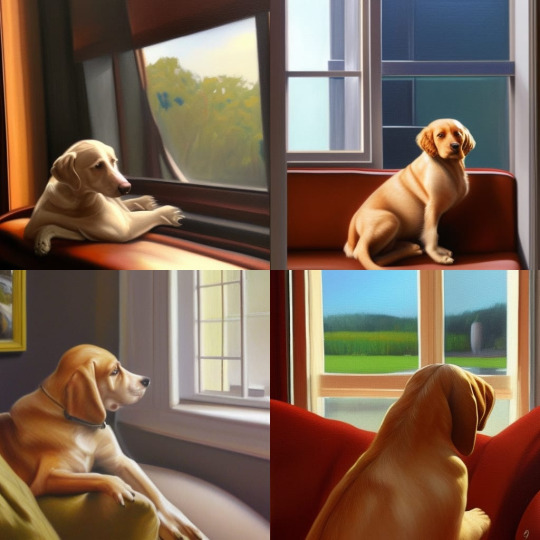
Algorithm: Stable
Model: Stable Diffusion v1.5
Text Prompt: Dog sitting on a couch looking out the window
Style: Oil Painting
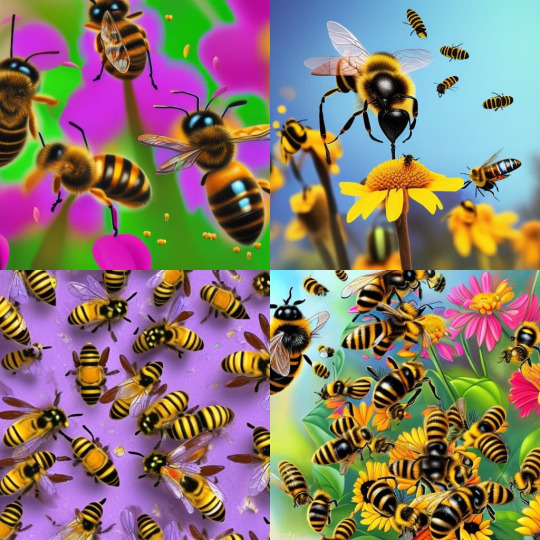
Algorithm: Stable
Model: State Diffusion v1.5
Text Prompt: Group of bees sitting on a flower about to be attacked by wasps
Style: Hyperreal
Text To Image - AI Image Generator API | DeepAI
Text Prompt: Battle of the Crayfish
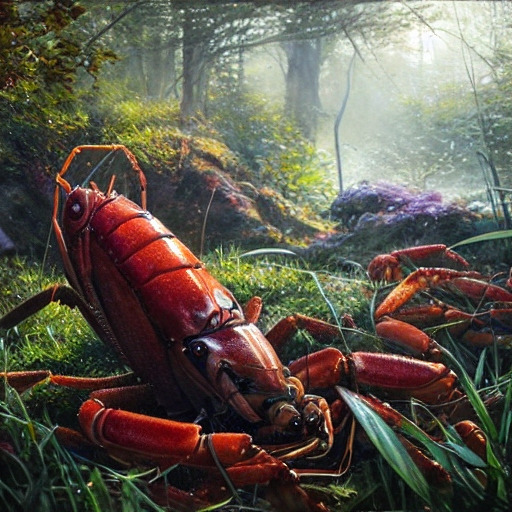
Style: Fantasy
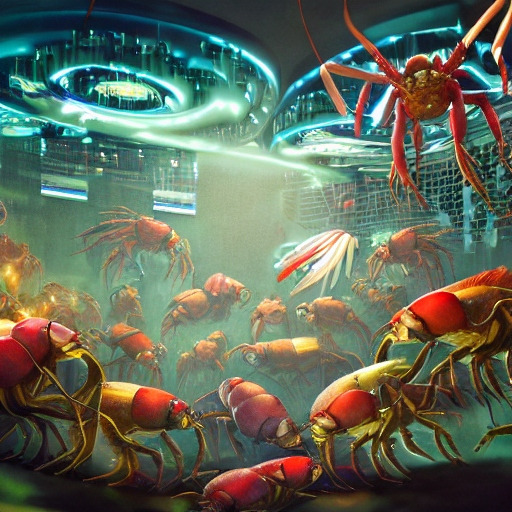
Style: Cyberpunk
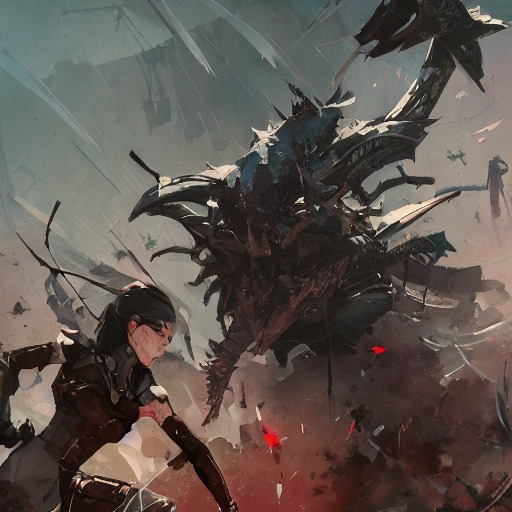
Style: Comic

Style: Impressionism
To me AI is an idea i find quite terrifying. We have seen so many movies about robots and computers taking over its not hard to see it as science fiction. But with the way technology is evolving so rapidly, it could quite easily replace us. From artists, to writers, graphic designers, photographers, AI can easily replace all of them. Leaving people who love their professions and have spend years building up their careers with nothing.
The Dark Side of Artificial Intelligence Art and its Impacts (analyticsinsight.net)
By Geetha Malathkar, November 29 2022
“New and exciting”, “gaining popularity quick”
“Potentioal for AI art used for polictical propaganda, to create fake art and to infringe on copyrights.”
“AI can now create realistic images, videos and even sculptures.”
“Sometimes indistinguishable from art created by humans”
“Because AI is powered by data, it is biased against underrepresented groups. For example, if an AI is trained on a data set of predominantly white male faces, it will more likely create art that is biased towards white male faces. This could lead to a future where the art world is dominated by biased AI created work.”
“This could lead to united consequences like the ones we have seen with discriminatory recruiting algorithms and microsoft’s twitter chatbox that became racist.”
“As companies build AI algorithms, they need to be developed and trained responsibly.”
Ai also massively reduces the time it takes to create pieces of art. In order to create the art i used in the ai generator, i had to type in a few keywords that best described he image I want to achieve. It also gave me a large variety of art styles I could chose from to get my ideal result. All those images combined took around 10 minutes to create. A significantly shorter amount of time it would take me to illustrate the same prompt by hand.
Although this could be somewhat beneficial to a lot of companies, it would completely rock the art world off its feet.
There is also a much larger chance of being hacked when using Ai generator programs. Behind each successful AI generator there is a programmer. It could be quite easy for them to input a series of codes and “take advantage of AI systems” that ultimately could lead them to getting into your hardware much easier.
CYBERARTS 2016
Prix Ars Electronic
Starts Prize '16
"The digital revolution that was recognisable on the horizon decades ago... Now constitutes the mainstream in media, business and politics." (pg 10)
"Dissatisfaction and mistrust are widespread" (pg 10)
"The artists and scientists involved in this project are not only paving the way for new developments, but also opening up totally new ways regarding the role of science in our society and the interplay of technology and nature." (pg 10)
"On the social level, this is a matter of new positive future scenarios of new social models, which are the approaches to a process of rethinking that seeks ways for us to livewell without growth." (pg 10)
INFERNO (pg 74-75)
Louis-Phillippe Dewers, Bill Vorn
"Participative robotic performance inspired by the concept of control."
"Bodies are handed to eternal and external forces controlling them."
"Shifting the exoskeletons command from the authors, to the computers and to the performers."
"Inferno questions the nature of control either mechanic or human."
"Also addresses recurrent issues revolving around the human-robot symbiotic relationships."
"Wearing or being entrapped in a robotic entity recalls the concept of the cyborg that emerged in the late 80s."
PATHFINDER (pg 82-83)
Generative approach for conceptional choreography
Qnformative in collaboration with Christian Loclair
"Generates and projects abstract shapes into space in order to simulate Danzers exploration."
"Digital approach to the conceptual research of Dance."
"Choreographers can adjust certain parameters of the algorithm - such as speed, complexity, or the geometry of objects."
"Pathfinder expands the idea of creative collaboration by integrating an intelligent digital entity to an artistic process."
0 notes
Text
Contextual Studies Independent Research
The Modern Age of Digital Cameras and Photoshop
How True is Photography?

(Figure 1.)
3D-Perspective Of Ovda Regio.
Venus, 1993.
NASA.
JPL Multimission Imaging Processing Laboratory,
Eric De Jong, Jeff Hall, Myche McAuley.
3D-Simulated Images
With photography becoming so digitised, it's not uncommon for scientists or researchers to be using high-end computers to create graphs, scans and 3D Models. (Figure 1.) This image depicts a computer simulated 3D-Perspective of the surface of venus. The process starts with a satellite that orbits the planet for a few years, collecting data by bouncing radar off the planet's surface. This process is called DEM (Digital Elevation Model). It is then taken through a process called ray tracing. This 3D-Simulation created by a phantom light-source and a “virtual camera” in a “virtual space”. ( pg 20, Photography Reborn, Jonathan Lupkin,). Computer programs can easily manipulate any image taken by a digital camera.
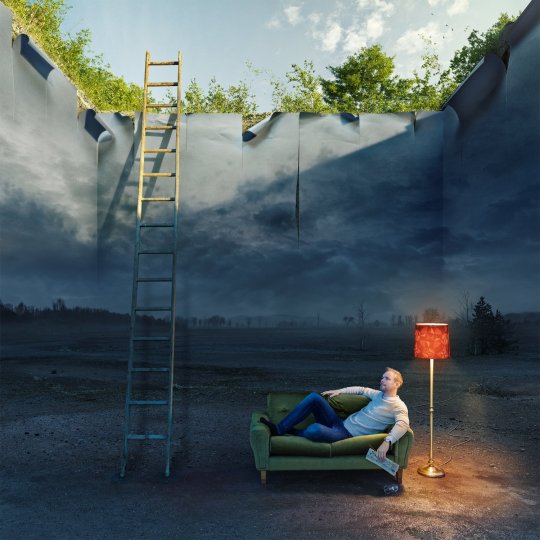
(Figure 2.)
Now Or Never Or Whenever
Erik Johansson
2020
Digital Montage
Digital collage is something you can see everywhere. Book covers, posters and advertisements are a few examples of where you would merge images together. (pg 64, Creative Visions, Jeremy Webb) This is usually when a foreground image gets taken separately to the background and are merge together. This is usually created in programs like Photoshop. With Digital Montage you can also create very surreal images. (Figure 2.) This is an image created by Swedish, surrealist photographer, Erik Johansson. A great example of how we can merge and manipulate images together, to create outcomes that look incredibly real. “Montage crosses boundaries.” (pg 68, Creative Vision, Jeremy Webb) Digital art allows to break boundaries of realism that traditional art might not be able to break as quickly or easily, resulting in an emotive way of manipulating what is and what isn’t real.
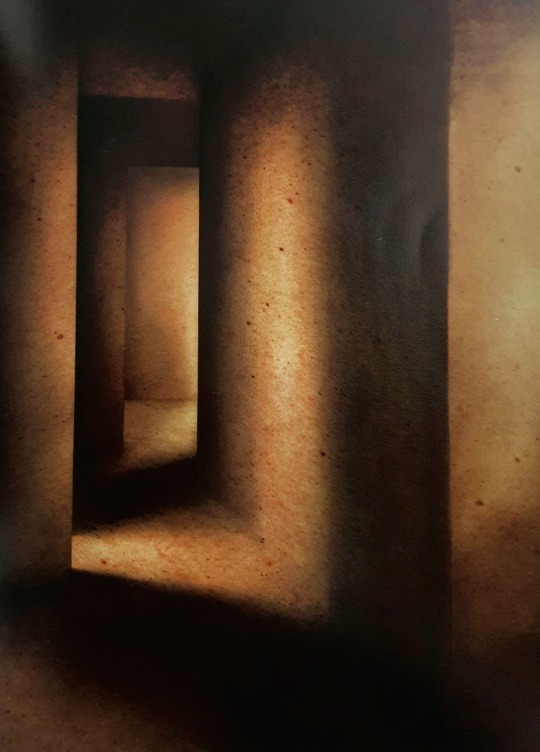
(Figure 3.)
Interior #6, Aziz + Cucher, 2000.
Dehumanisation
In our digital revolution, we as humans seem to have less barriers between things that are and are not human. We have more and more machines that think, talk and act like humans, and more things that turn us into machines. The art duo Aziz + Cucher explore this dehumanization, to where it can feel quite overwhelming. Although at first a normal seeming photo (Figure 3.), the room is actually edited where the walls, the floor, essentially everything is a photoshopped image of skin. The image conveys the idea of engineered living organisms, in a way that almost evoked this feeling of science and medicine gone wrong. (pg 69, Photography Reborn, Jonathan Lipkin).

(Figure 4.)
O2 Arena Edited Daylight
Marta Kepinska, 2023
Digital Montage Primary Image
In this digital collage, I wanted to edit an already existing photo with photographs of my own. By using various tools and filters, I am able to give the few photos I have added a bit more character similar to the background image. By adding the ducks and skyscrapers, I am able to build onto the original narrative and tell a story of my own. By over saturating the image (Figure 5.), I can add vividness into the image and capture the audience's eye much more effectively. By targeting saturation in certain colour, you can change the whole emotion of the image. “The digital tools allow us to have control over what and how we can alter an image, that was unimaginable in the era of analog.” (pg 79, Photography Reborn, Jonathan Lipkin.)

(Figure 7.) Original Photography, Digital Montage, London Lake Landscape, Marta Kepinska, 2021
Real? Or Fake?
The internet is a good example of places where images can easily be faked but believed to be real. From cropped images, propaganda and digitally altered images, a simple change can shift the whole narrative and alter the original message of the image. This can sometimes be harmful. Images on the internet travel like wildfire, so a manipulated image spreading fake news can be detrimental. (Figure 8) Is an altered version of a photograph I had already taken. This picture shows that the thames taken roughly around embankment, but with a London skyline that doesn’t exist. For someone who doesn’t know much about London, an image like this can get someone's hopes up or stranded looking for a place that doesn’t exist.
REFERENCING
(Figure 1.) 3D-Perspective Of Ovda Regio, Venus, 1993. NASA, JPL Multimission Imaging Processing Laboratory, Eric De Jong, Jeff Hall, Myche MC Auley.
(Figure 2.) Now Or Never Or Wherever, Erik Johansson, Surrealist Photographer, 2020
(Figure 3.) Interior #6, Aziz + Cucher, 2000. C-Print, 72 x 50 inches. Courtesy Henry Urbach Gallery, New York
(Figure 4.) 02 Arena Edited Daylight, Marta Kepinska, 2023
(Figure 5.) 02 Arena Unedited, mikecphoto, Shutterstock
(Figure 6.) 02 Arena Oversaturated, Marta Kepinska, 2023
(Figure 7.) Original Photography, Lake Landscape, Marta Kepinska, 2021
(Figure 8.) Edited Photography, London Lake Landscape, Marta Kepinska, 2023
Creative Vision, Digital & Traditional Methods for Inspiring Innovative Photography. Jeremy Webb. 2005
Photography Reborn. Image Making In The Digital Era. Jonathan Lipkin. 2005
0 notes
Text
Robert Capa - Death of a Loyalist Soldier (1936)
(The Falling Soldier)
“There can be no evidence, photographic or otherwise, of an event until the event itself has been named and characterised. And it is never photographic evidence which can construct… events.”
“Although there is a sense in which the camera does indeed capture reality, not just interpret it, photographs are as much an interpretation of the world as paintings and drawings are.”
“Art is always manipulation from the moment you point a camera in one direction and not another” (Spanish Culture Minister - Angeles Gonzalez-Sinde)
This photo shows a soldier, mid-collapse from a fatal gunshot, during the battle of Cerramuriano in the Spanish Civil War. Named world’s greatest war photographer by British Magazine “picture post”, capa (who studied journalism and political science) often found himself photographing war settings, “The Falling Soldier”, being one of his most famous images in the world of war photography. I think this picture is incredibly powerful in depicting the fragility of life but also highlights moment in time, pausing on the exact moment between life and death. It also gives the viewer of the image a chance to reflect on the delicate nature of mortality. The composition of the image is also quite striking. Capa chose to crop this composition to bring the focal point to the action. He also crops off the shotgun in the soldier's hand, almost as if stripping the power away from the man.
Although it is considered to be one of the most famous photographs in the world, it is also faced with a lot of critics, claiming that this image was staged. A communications professor, Jose Manuel Susperregui, states that Capa’s picture was taken in another town, 35 miles away from the battle lines. As it wasn’t taken in the frontlines, many people automatically claim it to be fake. Research wasn’t taken in the heat of battle but instead during a maneuver where it was said to be covered by snipers.
0 notes
Text
Photography Briefing (Notes) - 24/02/23
Project - understanding a photography - due end of march
Uploaded to social media and the rest sort of disappear and we forget about them
If we didn't document it, did we even go? We document everything in order to evidence that we had been there.
Today everything exists to end in a photograph
Susan Sontag
Most concerts are filled with phones
Everyone has a camera, everyone is technically a photographer
We will investigate the medium of photography, its ability to tell a story or ‘promise truth’. We often don't trust photographic images as much as we used to. A lot are staged/manipulated to evoke a certain feeling. Also looking at war photography as well as the internet and the role it has with photography.
How to integrate quotes?
Create a photo essay, acting more like the curators of an exhibition, piecing together 5 images and thinking what story that's telling, extended viewer captions.
Images can be from media, social media, various ways of being about to take a photograph.
Artists to look at:
Vivian Maier, Don Mccullin, Robert Capa, Diane Arbus, Cindy Sherman, Sally Mann, Nan Goldin, Robert Mapplethorpe, Francesca Woodman, Jon Rafman
In Plato's Cave
“To collect photographs, is to collect the world”
“With still photographs the image is also an object”
A memory that is shared and distributed.
“Photographs are the most mysterious of all the objects that make up, thicken, the environment we recognise as modern. Photographs really are experience captured, and the camera is the ideal arm of consciousness in its acquisitive mood”
“To photograph is to appropriate the thing photographed”
“It means putting oneself into a certain relation to the world that feels like knowledge”
We believe it to be the truth
”It’s like power”
“Photographic images, which now provide most of the knowledge people have about the look of the past and the reach of the present”
Easier to read images that text.
“What is written about a person or an event is frankly an interpretation… photographed images do not seem to be statements about the world so much as pieces of it, miniatures of reality that anyone can make or acquire.”
“They are reproduced”
For many decades the book has been the most influential way of arranging photographs thereby guaranteeing them longevity, if not immortality - photographs are fragile objects, easily torn or mislaid.”
“Emotional impact”
“Photographs furnish evidence”
“Something we hear about, but doubt, seems proven when we are shown a photograph of it.”
Telling someone then showing evidence to back it up.
“A photograph passes for incontrovertible proof that a given thing has happened”
Has someone cropped it to change the narrative? Has someone manipulated it to change its meaning?
“The work that photographers do is no generic exception to the usually shady commerce between art and truth”
“A photogram is both a pseudo-presence and a token of absence. Like a wood fire in a room, photographs - especially those of people, of distant landscapes and faraway cities, of the vanished past - are incitements to reverie.”
“A photograph that brings news of some unsuspected zone of misery cannot make a dent in public opinion unless there is an appropriate context of feeling and attitude.”
“Photographs may be more memorable than moving images, because they are a neat slice of time, not a flow.”
“There can be no evidence, photographic or otherwise, of an event until the event itself has been named and characterised. And it is never photographic evidence which can construct… events.”
“Although there is a sense in which the camera does indeed capture reality, not just interpret it, photographs are as much an interpretation of the world as paintings and drawings are.”
Neil Armstrong On the moon
When the moon landing was televised, the public all believed out because of the picture. But nowadays we look back at the image and the video and we often doubt if this is true. On the images you would see cross hairs, implying that the images were stitched together.
In other images lines were captured as if supporting and harnessing Armstrong. The flag was also seen moving.
I think this shows how much we doubt the things around us including photographs compared to the past.
“Photographs furnish evidence. Something we hear about, but doubt, seems proven when we’re shown a photograph of it.”
"After the event has ended, the picture will still exist, conferring never otherwise have enjoyed "
“A photograph passes for incontrovertible proof that a given thing has happened”
“Although there is a sense in which the camera does indeed capture reality, not just interpret it, photographs are as much an interpretation of the world as paintings and drawings are.”
0 notes
Text
Propaganda: The Big Con
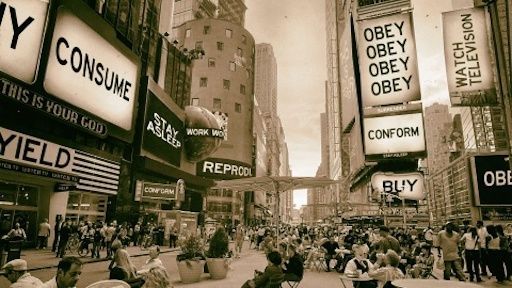
Propaganda. What is it? Where has it come from? How do we change social norms for profit? How do we manipulate public opinion to benefit the interest of the few? How does propaganda shape our world? And who shapes it?
Before World War One, the word propaganda was not commonly used in the English language and when it was, it was mainly used by social activists. The word propaganda often resided with Catholics before it was changed into a political term in the 19th century. This term had then been associated with secret organisations spreading opinions and often lies in order to influence public opinion and to create a bias. This is also when the word started to get a negative connotation surrounding it.
Although, many believe propaganda is mainly spread through posters, it is much more versatile in which media it presents itself in. Many other ways it is used include: speeches, radio and film. Nowadays, it can be hiding anywhere and affect a much larger group in a shorter amount of time. Especially with the use of social media and influencers, many can now simply voice their opinions and sway a large audience in one sitting. Many politicians also use social media to spread slander and dishonesty, in hopes of swaying the public and winning their votes. And another common way is through advertisements and consumerism.
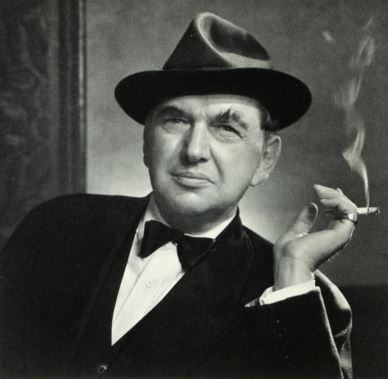
In 1928, George Washington Hill, president of an American tobacco company, wanted to find a way to persuade women to smoke. In a day and age where World War One had just ended (10 years ago), and women finally had the right to vote, Hill craved for more than he had. At the time it was socially taboo for women to smoke and only permitted for men to do so. A woman smoking at the time was often seen as immoral or as a prostitute. This was until Hill reached out to one of the pioneers of propaganda, Edward Bernays.

Edward Bernays, an Austrian-American publicist and nephew to Sigmund Freud, is considered to be one of the first to develop the idea of Public Relations. He often used social sciences in order to shape the way the consumer saw a certain product/situation. In order to encourage more people to invest into the tobacco company, Bernays decided to target a demographic that craved something they didn't have for a long time. Freedom. And thus the campaign “Torches of Freedom” was born. This way Bernays linked a product to an idea, an idea of freedom. He used the statement “Torches of Freedom”, as a way to empower women, free themselves and be equals to men. He proceeded to then hire attractive women to march and light their “Torches of Freedom” another way he exploited women’s hopes of a better life at the time and encouraged more to join. Although this stunned many, and many men saw it as a threat, it was one of the ways women were able to fight against emancipation and to change social norms. It finally became a symbol for rebellious independence, glamour and seduction.

We can often see propaganda in most of the products we use. Consumerism is generally often used to control society. In this day and age where inflation is through the roof. We are all often attempting to save every penny, every dime we can. This is when big deals such as black friday and cyber monday can strategically not only encourage people to spend more money, but also to distract from everything else going on in the world. Black Friday in particular doesn’t have one of the best origins. Although many people correlate the day with thanksgiving and christmas shopping, the origin actually has a little less in common. One of the first times we’ve ever heard this phrase was in 1869, it was created by a severe plummet in gold prices that eventually caused a market crash and affected the American economy for a long time to come. In later times, it then had many correlations with other negative events such as in Philadelphia when people crowded the streets in hopes of finding post thanksgiving deals, ultimately leading to mass chaos. Police had to deal with traffic jams, accidents and shoplifting. Because of the negative implications surrounding black friday, it was attempted to be renamed to “Big Friday”, something that seemed more joyous. However, that didn’t stick as many companies referred to the day as red-to-black profit. Nowadays, events such as black friday are often used to feed into capitalism. People fight over items that might have not even been reduced too much, over spend on things they don’t really need and usually because of the mass chaos it ensues, many are often scrolling through social media to see footage of the chaos, ultimately distracting them from real life situations. Another example of consumerist propaganda is the pink tax.

Pink tax markets universal products specifically to women, often at a much higher price point. From razors, hairbrushes, personal care to even face masks. Products marketed for women are at a much higher price point than those for men and are often labelled as more sensitive or fragile and state that “women are more concerned about personal care, so they’ll be willing to pay more”.
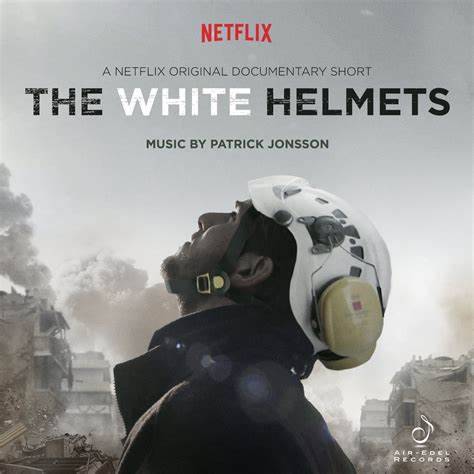
Other than capitalism, one of the most recent instances we have of political propaganda, comes from the Russian v Ukraine war. Disinformation such as: manipulated photographs, state propaganda and deep fake videos are all used to intimidate and gain advantage over the other country. Another fairly recent example of propaganda and mass disinformation surrounded a first responder team in Syria, the White Helmets. This group was known to save thousands of lives everyday as they worked on the first aid frontline of the civil war and even had a Netflix show. The information around the White Helmets is quite messy, many believing they have been nothing but a PR stunt to paint the western world as heroic when in fact it was all staged (this claim was more often made by the Russian and Syrian government in hopes of painting them as the good guys). Some believed they were real but intensified their videos in order to gain more of a shock factor. Others were shocked that they had decided to film a video surrounding the mannequin challenge, where whilst pulling a boy out of rubble they are frozen mid-rescue, this creating a surge of more people questioning the truth.

A lot of the time propaganda is filled with ill intent, often benefiting the organisation/individual behind the disinformation over the viewer. We see it everyday. We see it everywhere. But we are rarely ever able to recognise it. From distractions, emotional manipulation and self-guilt these are all tactics used by those behind the creation of propaganda.
Referencing:
Dedaić, M.N. and Nelson, D.N. (2003) At war with words. Reprint 2012. Edited by M.N. Dedaić and D.N. Nelson. Hawthorne, New York: Mouton de Gruyter. Available at: https://doi.org/10.1515/9783110897715.
Delgado, J. (2022, May 9). Propaganda today: how has it been transformed to continue manipulating us? Psychology Spot. https://psychology-spot.com/propaganda-today/
Beck, A. (2022, November 15). Platforms of Propaganda: How Social Media Sites Facilitate and Spread Disinformation. MIR. https://www.mironline.ca/platforms-of-propaganda-how-social-media-sites-facilitate-and-spread-disinformation/
Dirty British propaganda war against Syria exposed. (2020, October 16). The Communists. https://thecommunists.org/2020/10/16/news/dirty-british-propaganda-war-against-syria-exposed/
Wesolowski, K. (2022, April 28). Fake news further fogs Russia’s war on Ukraine. dw.com. https://www.dw.com/en/fact-check-fake-news-thrives-amid-russia-ukraine-war/a-61477502
Hadjimatheou, B. C. (2021, February 27). Mayday: How the White Helmets and James Le Mesurier got pulled into a deadly battle for truth. BBC News. https://www.bbc.co.uk/news/stories-56126016
Vaughan, D. (2022). Why Is It Called Black Friday? [online] Encyclopedia Britannica. Available at: https://www.britannica.com/story/why-is-it-called-black-friday.
HuffPost UK. (2019). You Probably Don’t Know The Dark Reason ‘Black Friday’ Got Its Name. [online] Available at: https://www.huffingtonpost.co.uk/entry/black-friday-history-why-is-it-called-black-friday_l_5d951322e4b02911e1154386.
Highsnobiety. (2016). How Consumerism Is Used to Control Society. [online] Available at: https://www.highsnobiety.com/p/consumerism-social-control/.
Edward Bernays | American publicist. (2019). In: Encyclopædia Britannica. [online] Available at: https://www.britannica.com/biography/Edward-Bernays.
0 notes
Text
Propaganda - Draft 1 (About 500 words)
For my personal project, I decided to focus on the topic of Propaganda, whilst also briefly linking it to technological innovation and how propaganda effects us now in a modern world full of easily accessible fake news. I decided to focus on propaganda as it is not a topic I have thoroughly researched previously and wanted to broaden my knowledge.

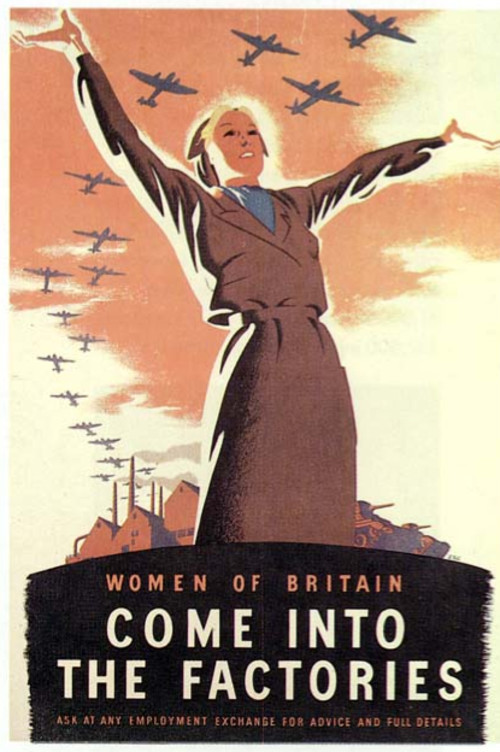

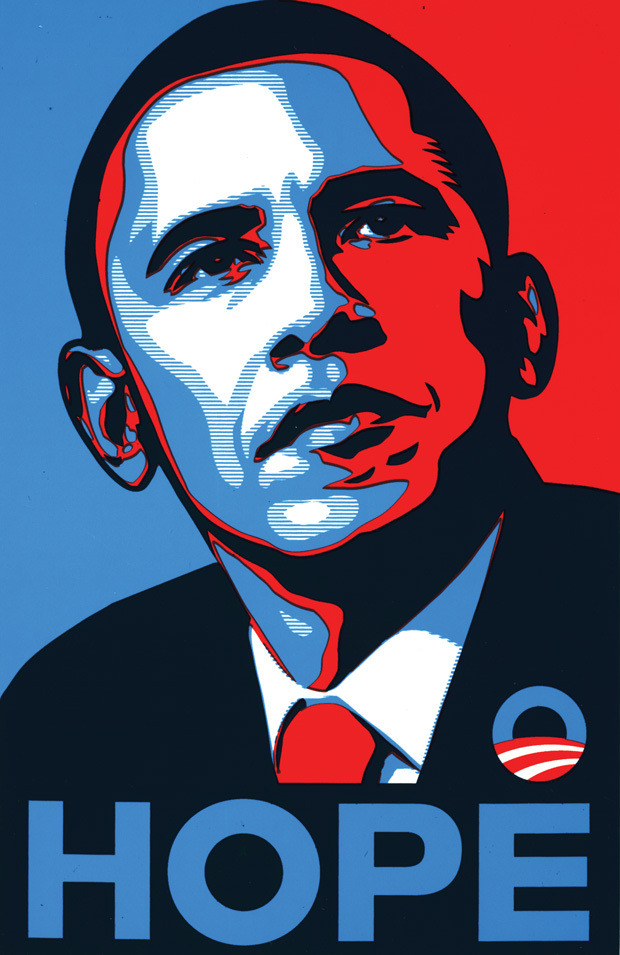
Before WW1, the word propaganda was not commonly used in the English language and when it was, it was mainly used by social activists. The word propaganda often resided with Catholics before it was changed into a political term in the 19th century. This term had then been associated with secret organizations spreading opinions and often lies in order to influence public opinion and to create a bias. This is also when the word started to get a negative connotation surrounding it.
Although, many believe propaganda is mainly spread through posters, it is much more versatile in which media it presents itself in. Many other ways it is used include: speeches, radio and film. Nowadays, it can be hiding anywhere and affect a much larger group in a shorter amount of time. Especially with the use of social media and influencers, many can now simply voice their opinions and sway a large audience in one sitting. Many politicians also use social media to spread slander and dishonesty, in hopes of swaying the public and win their votes.
One of the most recent instances we have of political propaganda, comes from the Russian v Ukraine war. Disinformation such as: manipulated photographs, state propaganda and deep fake videos are all used to intimidate and gain advantage over the other country. Another fairly recent example of propaganda and mass disinformation surrounded a first responder team in Syria, the White Helmets. This group was known to save thousands of lives everyday as they worked on the first aid frontline of the civil war and even had a Netflix show. The information around the White Helmets is quite messy, many believing they have been nothing but a PR stunt to paint the western world as heroic when in fact it was all staged (this claim was more often made by the Russian and Syrian government in hopes of painting them as the good guys). Some believed they were real but intensified their videos in order to gain more of a shock factor. Others were shocked that they had decided to film a video surrounding the mannequin challenge, where whilst pulling a boy out of rubble they are frozen mid-rescue, this creating a surge of more people questioning the truth.
A lot of the time propaganda is filled with ill intent, often benefiting the organization/individual behind the disinformation over the viewer. We see it everyday. We see it everywhere. But we are rarely ever able to recognize it. From distractions, emotional manipulation and self-guilt these are all tactics used by those behind the creation of propaganda.
Sources:
Dedaić, M.N. and Nelson, D.N. (2003) At war with words. Reprint 2012. Edited by M.N. Dedaić and D.N. Nelson. Hawthorne, New York: Mouton de Gruyter. Available at: https://doi.org/10.1515/9783110897715.
Delgado, J. (2022, May 9). Propaganda today: how has it been transformed to continue manipulating us? Psychology Spot. https://psychology-spot.com/propaganda-today/
Beck, A. (2022, November 15). Platforms of Propaganda: How Social Media Sites Facilitate and Spread Disinformation. MIR. https://www.mironline.ca/platforms-of-propaganda-how-social-media-sites-facilitate-and-spread-disinformation/
Dirty British propaganda war against Syria exposed. (2020, October 16). The Communists. https://thecommunists.org/2020/10/16/news/dirty-british-propaganda-war-against-syria-exposed/
Wesolowski, K. (2022, April 28). Fake news further fogs Russia’s war on Ukraine. dw.com. https://www.dw.com/en/fact-check-fake-news-thrives-amid-russia-ukraine-war/a-61477502
Hadjimatheou, B. C. (2021, February 27). Mayday: How the White Helmets and James Le Mesurier got pulled into a deadly battle for truth. BBC News. https://www.bbc.co.uk/news/stories-56126016
Image Sources (in order of photographs):
Norman Rockwell, US, 1939
Phillip Zec, England, 1930
Shepard Fairey, US, 2008
Hans Schweitzer, Germany, 1930s
1 note
·
View note
Text
Sleep Manifesto - Group Work
This is our group manifesto about sleep. Although I usually prefer to work alone, I am happy with how we all worked together to arrange and create our presentation. Luckily, we managed to decide our topic very early on, which allowed us to concentrate on the research and execution. After brainstorming we each chose a topic that we were most interested in and compiled all of our work onto a Google Slide document, that was easily accessible by all of us.
The part I had focused on was The Dream Journal slide (as well as the illustration on that slide) and the artist research about Lee Hadwin. I included his work just purely due to fascination about how he created his work in his sleep.
I really enjoyed the research, which in return helped inspire me when creating my illustration. Although, I personally still find it a bit difficult to recognize what a manifesto is and what it includes.
Overall, I am happy with our groups outcome and pleased we all worked well together.
0 notes
Text
Liberate Tate
For my manifesto, I decided to choose to focus on Liberate Tate. This manifesto really resonated with me because of the way it was planned out and executed.
Liberate Tate is a movement supported by a group called Art Not Oil. In July 2012, their goal was to create art that spoke to the Tate gallery in hopes of them eventually cutting ties with BP. The artwork they created was a one-and-a-half-ton wind turbine they called "The Gift". At the time, over 1000 people signed a petition "bring back the wind turbine into the hall".
This demand for Tate cutting ties with BP was even more urgent following the Gulf of Mexico disaster. Where an oil rig (Deepwater Horizon) exploded and sank causing the death of 11 workers and the largest oil spill in the history of marine oil drilling. They report it was caused by defective cement on the well. The oil is still detectable now, 10 years later.
This majorly effected gallery goers as many felt torn about going to galleries as they felt that this was, they would be supporting oil companies such as BP.
By giving the wind turbine to the Tate meant that the gallery had to process the artwork and consider it as an entry for Tates permanent collection.
The execution of this protest was done very well and had many legal/health and safety measures in check, to ensure that the whole operation ran smoothly. This in comparison to many current protests (such as Just Stop Oil) has been a more effective way to protest as it was controlled/planned out and didn't damage any existing pieces of art.
In my opinion this protest was incredibly successful and should be locked at one of the base ways to protest in the future.
0 notes
Text
For my iteration I decided I wanted to map out the area that I was walking in. In my video, it shows me walking through different areas at night. All of these areas are compacted to one estate. The estate was generally like a maze with various turns and paths, but it all felt connected. While shooting the video I also took note of all the turns I took and the things around me. Something industrial things I stumbled across included, playgrounds, football pitches and blocks. Most of this estate was made completely out of concrete. Some more organic things i stumbled across were trees, bushes, large empty patches of grass and wildlife such as snails, foxes and birds.
I thought this would be a good area to explore as so much is compacted into one little space.
0 notes
Text
My Psychogeographic Video Evaluation
This video is my response to both Jonas Mekas and Richard Long, two artists that document psychogeographic art. I was inspired by Jonas Mekas to record the visuals and the sounds of the area I was in. In order to be able to respond well to the concept of a derive, I thought that following in a similar style to Mekas permitted me to focus on the terrain around me. By turning on a camera and allowing it to capture the environment, I was able to achieve an organic result. A walk can’t be planned. Things can happen unexpectedly; It can start to rain, people or animals can appear out of nowhere or a wrong turn could result in a completely new and undiscovered location. This idea is what generally struck me the most about Mekas work.
I chose to record this at night. This is because although the dark outside is often feared, I believe it can be filled with serenity. The area itself is quite quiet in the later evening in comparison to daytime which is much livelier. This way my video was able to capture much more hidden sounds that might not necessarily have been heard during the waking hours. This is just one of the many factors that can influence psychogeographic mapping.
The other artist I wanted to include was Richard Long. I liked the idea of him being recorded as he walked, almost as if the watcher was there with him. I also attempted to recreate his terrain tracing method within the limited area I was in.
0 notes
Text
Psychogeographic Walk Inspired by Jonas Mekas and Richard Long
0 notes
Text
Project 1 - Keep Walking Intently
My Bus Journey Home
White fluffy clouds float by in the crisp and clear ocean blue sky. The sun shines bright through the bus window, illuminating the few people sitting on the top bunk. The seats are blue with specks of red, yellow and purple. The bus railings also have a vibrant eye catching yellow. An occasional tree or bush sways in the front yard of the houses blurring by, peeking out ever so slightly behind the large gates, clanking against the roof of the double-decker bus. Cars speed by on the highway, engines roaring through the thin glass. The pavements are laid out with white, red and brown houses. Modern with a hint of traditional old English. Although crowded with cars and buildings, the area itself is baren of any pedestrians. A quite tune can be heard playing from the passenger beside me. The song seemingly blending in with dings of bus, signaling that it was my time to get off.
1 note
·
View note
